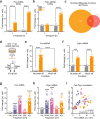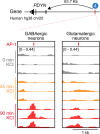Temporally specific gene expression and chromatin remodeling programs regulate a conserved Pdyn enhancer
- PMID: 37938195
- PMCID: PMC10631760
- DOI: 10.7554/eLife.89993
Temporally specific gene expression and chromatin remodeling programs regulate a conserved Pdyn enhancer
Abstract
Neuronal and behavioral adaptations to novel stimuli are regulated by temporally dynamic waves of transcriptional activity, which shape neuronal function and guide enduring plasticity. Neuronal activation promotes expression of an immediate early gene (IEG) program comprised primarily of activity-dependent transcription factors, which are thought to regulate a second set of late response genes (LRGs). However, while the mechanisms governing IEG activation have been well studied, the molecular interplay between IEGs and LRGs remain poorly characterized. Here, we used transcriptomic and chromatin accessibility profiling to define activity-driven responses in rat striatal neurons. As expected, neuronal depolarization generated robust changes in gene expression, with early changes (1 hr) enriched for inducible transcription factors and later changes (4 hr) enriched for neuropeptides, synaptic proteins, and ion channels. Remarkably, while depolarization did not induce chromatin remodeling after 1 hr, we found broad increases in chromatin accessibility at thousands of sites in the genome at 4 hr after neuronal stimulation. These putative regulatory elements were found almost exclusively at non-coding regions of the genome, and harbored consensus motifs for numerous activity-dependent transcription factors such as AP-1. Furthermore, blocking protein synthesis prevented activity-dependent chromatin remodeling, suggesting that IEG proteins are required for this process. Targeted analysis of LRG loci identified a putative enhancer upstream of Pdyn (prodynorphin), a gene encoding an opioid neuropeptide implicated in motivated behavior and neuropsychiatric disease states. CRISPR-based functional assays demonstrated that this enhancer is both necessary and sufficient for Pdyn transcription. This regulatory element is also conserved at the human PDYN locus, where its activation is sufficient to drive PDYN transcription in human cells. These results suggest that IEGs participate in chromatin remodeling at enhancers and identify a conserved enhancer that may act as a therapeutic target for brain disorders involving dysregulation of Pdyn.
Keywords: CRISPR; chromatin; enhancer; gene regulation; human; neuroscience; rat; striatum; transcription.
© 2023, Phillips et al.
Conflict of interest statement
RP, EW, JT, DR, OD, LI No competing interests declared, JD Reviewing editor, eLife
Figures













Update of
-
Temporally specific gene expression and chromatin remodeling programs regulate a conserved Pdyn enhancer.bioRxiv [Preprint]. 2023 Aug 21:2023.06.02.543489. doi: 10.1101/2023.06.02.543489. bioRxiv. 2023. Update in: Elife. 2023 Nov 08;12:RP89993. doi: 10.7554/eLife.89993. PMID: 37333110 Free PMC article. Updated. Preprint.
References
-
- Benjamini Y, Hochberg Y. Controlling the false discovery rate: a practical and powerful approach to multiple testing. Journal of the Royal Statistical Society. 1995;57:289–300. doi: 10.1111/j.2517-6161.1995.tb02031.x. - DOI
-
- Bertran-Gonzalez J, Bosch C, Maroteaux M, Matamales M, Hervé D, Valjent E, Girault J-A. Opposing patterns of signaling activation in dopamine D1 and D2 receptor-expressing striatal neurons in response to cocaine and haloperidol. The Journal of Neuroscience. 2008;28:5671–5685. doi: 10.1523/JNEUROSCI.1039-08.2008. - DOI - PMC - PubMed
-
- Brin S, Page L. The anatomy of a large-scale hypertextual Web search engine. Computer Networks and ISDN Systems. 1998;30:107–117. doi: 10.1016/S0169-7552(98)00110-X. - DOI
Publication types
MeSH terms
Substances
Associated data
- Actions
- Actions
- Actions
- Actions
- Actions
- Actions
- Actions
- Actions
Grants and funding
LinkOut - more resources
Full Text Sources
Molecular Biology Databases
Research Materials
Miscellaneous

